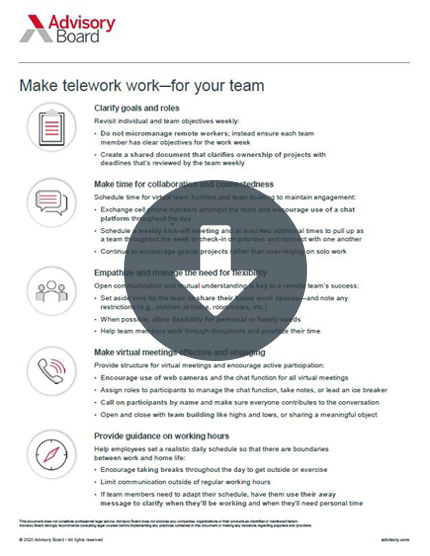Auto logout in seconds.
Continue LogoutWriting for Harvard Business Review, Tomas Chamorro-Premuzic, a professor of business psychology at University College London and Columbia University, and Katarina Berg, CHRO and global head of strategy operations at Spotify, explain three challenges leaders must address to effectively develop a "culture of belonging"—especially as more organizations move towards hybrid work.
'It's not complicated, but it's really hard': 3 ways to promote a culture of respect
Why a 'culture of belonging' is important
According to Chamorro-Premuzic and Berg, research suggests that what makes work meaningful for employees is a sense of belonging, whether to a team or within the larger organization.
For example, employees who feel they belong to an organization will perform better, be more engaged, and have a greater sense of well-being. In contrast, feeling disconnected can lead to employees feeling alienated and burned out, which can in turn affect their performance, Chamorro-Premuzic and Berg write.
As hybrid work becomes more common, Chamorro-Premuzic and Berg encourage organizations to think beyond a "homogeneous cultural experience" for their workers—and overcome three challenges in particular.
1. Balancing a strong culture with diversity, inclusion, and belonging (DIB) practices
"To elevate the importance of diversity, companies need to harness an inclusive culture where people feel valued and respected, and perhaps even recruited, for their differences," Chamorro-Premuzic and Berg write.
To establish this DIB culture, Chamorro-Premuzic and Berg encourage employers not to focus on determining whether someone "fits" with the culture when hiring. Instead, employers should think about what someone "adds" to a work culture, whether that's a new perspective or different background.
Chamorro-Premuzic and Berg acknowledge that this approach may result initially in misunderstandings and conflicting opinions as people from different backgrounds try to work together. But the authors say that having managers understand and commit to this effort will ultimately create a stronger overall culture.
2. Encouraging socialization—even as some people work from home
According to Chamorro-Premuzic and Berg, work is a critical "opportunity to have meaningful connections with others." In fact, being able to make social connections is the main reason many people miss working in the office.
But while those eager and able to return to the office will be able to experience a sense of belonging by interacting with others in person, the situation is different for remote employees, Chamorro-Premuzic and Berg write. As a result, as organizations move toward hybrid work, they will need to balance offering support for employees working remotely while still helping them stay connected and be an active part of the company's culture at the office.
For example, a recent employee survey at Spotify found that employees' biggest concern was how to foster a sense of belonging while working from home. This led the company's leaders to assess their organization and find ways to foster a sense of community for everyone—in different locations and circumstances.
3. Allowing culture to evolve when necessary
Chamorro-Premuzic and Berg write that although it may be tempting to "cling to the past," large, external changes—such as the pandemic or a move to hybrid work—mean that an organization's culture will have to evolve and adapt.
As organizations develop their own cultures, Chamorro-Premuzic and Berg offer a few suggestions for how offices might function in hybrid work arrangements, such as establishing:
- Collaborative, creative spaces that allow for stimulating in-person meetings
- Social and community spaces for employees, rather than making the office just a place to work
- Key internal networking spaces, particularly for "Generation Covid," who will enter the job market after Gen Z
"No matter what approach you choose," Chamorro-Premuzic and Berg write, "it is always important to make it explicit, to ensure that people understand your rationale, and to have the humility and data-informed mindset to evaluate what works, and what doesn't, and to be ready to adjust accordingly." (Chamorro-Premuzic/Berg, Harvard Business Review, 8/3)
Don't miss out on the latest Advisory Board insights
Create your free account to access 1 resource, including the latest research and webinars.
Want access without creating an account?
You have 1 free members-only resource remaining this month.
1 free members-only resources remaining
1 free members-only resources remaining
You've reached your limit of free insights
Become a member to access all of Advisory Board's resources, events, and experts
Never miss out on the latest innovative health care content tailored to you.
Benefits include:
You've reached your limit of free insights
Become a member to access all of Advisory Board's resources, events, and experts
Never miss out on the latest innovative health care content tailored to you.
Benefits include:
This content is available through your Curated Research partnership with Advisory Board. Click on ‘view this resource’ to read the full piece
Email ask@advisory.com to learn more
Click on ‘Become a Member’ to learn about the benefits of a Full-Access partnership with Advisory Board
Never miss out on the latest innovative health care content tailored to you.
Benefits Include:
This is for members only. Learn more.
Click on ‘Become a Member’ to learn about the benefits of a Full-Access partnership with Advisory Board
Never miss out on the latest innovative health care content tailored to you.

